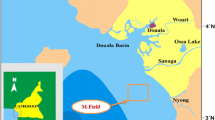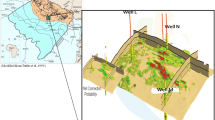Abstract
Well log analysis provides the information on petrophysical properties of reservoir rock and its fluid content. The present study depicts interpretation of well log responses such as gamma ray, resistivity, density and neutron logs from six wells, namely W-1, W-2, W-9, W-12, W-13 and W-14 under the study area of Krishna-Godavari (K-G) basin. The logs have been used primarily for identification of lithology and hydrocarbon-bearing zones. The gamma ray log trend indicates deposition of cleaning upward sediment. Coarsening upward, clayey-silty-sandy bodies have been evidenced from the gamma ray log. Gas-bearing zones are characterised by low gamma ray, high deep resistivity and crossover between neutron and density logs. Total 14 numbers of hydrocarbon-bearing zones are identified from wells W-9, W-12, W-13 and W-14 using conventional log analysis. Crossplotting techniques are adopted for identification of lithology and fluid type using log responses. Crossplots, namely P-impedance vs. S-impedance, P-impedance vs. ratio of P-wave and S-wave velocities (Vp/Vs) and lambda-mu-rho (LMR), have been analysed to discriminate between lithology and fluid types. Vp/Vs vs. P-impedance crossplot is able to detect gas sand, brine sand and shale whereas P-impedance vs. S-impedance crossplot detects shale and sand trends only. LMR technique, i.e. λρ vs. μρ crossplot is able to discriminate gas sand, brine sand, carbonate and shale. The LMR crossplot improves the detectability and sensitivity of fluid types and carbonate lithology over other crossplotting techniques. Petrophysical parameters like volume of shale, effective porosity and water saturation in the hydrocarbon-bearing zones in these wells range from 5 to 37%, from 11 to 36 and from 10 to 50% respectively. The estimated petrophysical parameters and lithology are validated with limited core samples and cutting samples from five wells under the study area.






Similar content being viewed by others
References
Archie GE (1942) The electrical resistivity log as an aid in determining some reservoir characteristics. Trans AIME 146(1):54–62
Asquith, G. and Gibson, C., 1983, Basic well log analysis for geologists. AAPG methods in exploration series, Tulsa, pp.216
Avseth P, Mukerji T, Mavko G (2005) Quantitative seismic interpretation: applying rock physics to reduce interpretation risk. Cambridge University Press, Cambridge, U.K.
Bastia R, Nayak P (2006) Tectonostratigraphy and depositional patterns in Krishna offshore basin, Bay of Bengal. Lead Edge 25:839–845
Bateman RM (1985) Openhole log analysis and formation evaluation. Prentice Hall PTR, New Jersey, p 647
Chow JJ, Li M-C, Fuh S (2005) Geophysical well log study on the paleo environment of the hydrocarbon producing zones in the Erchungchi Formation, Hsinyin, SW Taiwan. TAO 16:531–543
Das B, Chatterjee R (2017) Wellbore stability analysis and prediction of minimum mudweight for few wells in Krishna-Godavari Basin, India. Int J Rock Mech Min Sci 93:30–37
Das B, Chatterjee R, Singha DK, Kumar R (2017) Post-stack seismic inversion and attribute analysis in shallow offshore of Krishna-Godavari basin, India. J Geol Soc India 90:32–40
Datta Gupta S, Chatterjee R, Farooqui MY (2012) Rock physics template (RPT) analysis of well logs and seismic data for lithology and fluid classification in Cambay basin. Int J Earth Sci 101(5):1407–1426
Eichkitz CG, Schreilechner MG, Amtmann J, Schmid C (2009) Shallow seismic reflection study of the Gschliefgraben landslide deposition area—interpretation and three dimensional modeling. Aust J Earth Sci 102:52–60
Ejedawe JE, Coker SJL, Lambert-Aikhionbare DO, Alofe KB, Adoh FO (1984) Evolution of oil-generative window and oil and gas occurrence in Tertiary Niger Delta Basin. AAPG Bull 68:1744–1751
Fertl, W. and Frost, E., 1980, Evaluation of shaly clastic reservoir rocks. Journal of Petroleum Technology, September, pp. 1641-1645
Gong C, Wang Y, Steel RJ, Olariu C, Xu Q, Liu X, Zhao Q (2015) Growth styles of shelf-margin clinoforms: prediction of sand- and sediment-budget partitioning into and across the shelf. J Sediment Res 85:209–229
Goodway, B., Chen T. and Downtown, J 1997, Improved AVO fluid detection and lithology discrimination using Lame petrophysical parameters, 67th Annual international Meeting, SEG, Expanded Abstracts, 183–186
Goodway B, Perez M, Varsek J, Abaco C (2010) Seismic Petrophysics and isotropic-anisotropic AVO methods for unconventional gas exploration. Lead Edge 29:1500–1508
Hasan MM, Akter F, Deb PK (2013) Formation characterization and identification of potential hydrocarbon zone for titas gas field, Bangladesh using wireline log data. Int J Sci Eng Res 4(5):1512–1518
Inichinbia S, Sule PO, Ahmed AL, Hamaza H, Lawal KM (2014) Petro physical analysis of among hydrocarbon field fluid and lithofacies using well log data. J Appl Geol Geophysics 2:86–96
Jipa CD (2012) Coarsening upward sedimentation in the Middle Pontian Dacian Basin, prograding shoreline or delta front? Geo-Eco-Marina 18:45–64
Kumar R, Das B, Chatterjee R, Sain K (2016) A methodology of porosity estimation from inversion of post-stack seismic data. Jf Nat Sci Eng 28:356–364
Leonard R (1983) Geology and hydrocarbon accumulations, Columbus Basin, offshore Trinidad. AAPG Bull 67:1081–1093
Manmohan M, Rao MRR, Kamraju AVVS, Yalamarty Y (2003) Origin and occurrence of Lower Cretaceous high gamma-high resistivity (Raghavapuram) shale—a key stratigraphic sequence for hydrocarbon exploration in Krishna-Godavari Basin, A.P. J Geol Soc India 62:271–289
Masoudi P, Tokhmechi B, Zahedi A, Jafari MA (2011) Developing a method for identification of net zones using log data and diffusivity equation. J Mining Environ 2(1):53–60
Mukerji T, Avseth P, Mavko G, Takahashi I, González EF (2001) Statistical rock physics: combining rock physics, information theory, and geostatistics to reduce uncertainty in seismic reservoir characterization. Lead Edge 20(3):313–319
Omudu, LM., Ebeniro, JO., Xynogalas, M., Osayande, N. and Olotu, S., 2008, Fluid discrimination and reservoir characterization from onshore Niger Delta, Society of Exploration Geophysicists, Annual General Meeting, Las Vegas, 2001–2005
Opara AI (2010) Prospectivity evaluation of ussol field, onshore Niger Delta Basin, using 3-D seismic and well log data. Pet Coal 52:307–315
Pendrel, J. and Riel, P V., 2000, Estimation and interpretation of P and S impedance volumes from simultaneous inversion of P-wave offset seismic data, Society of Exploration Geophysicists, Expanded Abstracts, 1–4
Popielski, A C., Heidari, Z., Verdin, C T., 2012, Rock classification from conventional well logs in hydrocarbon-bearing shale, SPE 159255, October, San Antonio
Poupon, A. and Leveaux, J., 1971, Evaluation of water saturation in shaly formations, Trans. SPWLA 12thAnnual Logging Symposium, pp.1–2
Quirein, J., Witkowsky, J., Truax, J. A., Galford, J. E., Spain, D. S. and Odumosu, T., 2010, Integrating core data and wireline geochemical data for formation evaluation and characterization of shale-gas reservoirs, SPE annual technical conference and exhibition, Paper id SPE-134559
Rao GN (2001) Sedimentation, stratigraphy, and petroleum potential of Krishna-Godavari basin, East Coast of India. AAPG Bull 85:1623–1643
Rider, M H., 1999, Geologic interpretation of well logs. Whittles Publishing Services
Rider, M H., 2002, The geological interpretation of well logs, 2nd edition. Rider-French Consulting Ltd, pp.280
Samantaray, S. and Gupta, P., 2008, An interpretative approach for gas zone identification and lithology discrimination using derivatives of λ∗ρ and μ∗ρ attributes, 7th Biennial International Conference and Exposition on Petroleum Geophysics, Society of Petroleum Geophysicists, Hyderabad, 386–341
Sarasty, J J. and Stewart, R R., 2003, Analysis of well-log data from the white rose oilfield, offshore Newfoundland, CREWES Research Report, 15
Schlumberger, 1972, The essentials of log interpretation practice, Services Techniques Schlumberger, pp. 58
Selley, R C., 1998, Elements of petroleum geology. Department of Geology, Imperial College, London, 37-145
Seni SJ, Desselle BA, Standen A (1994) Scope and construction of a gas and oil atlas series of the Gulf of Mexico: examples from Texas offshore lower Miocene plays. Gulf Coast Assoc Geol Soci Trans 44:681–690
Shrivastava, C., Ganguly, S. and Khan, Z., 2008, Reconstructing sedimentary depositional environment with borehole imaging and core: a case study from eastern offshore India, International Petroleum Technology Conference, Kuala Lumpur, December
Singha D, Chatterjee R (2017) Rock physics modeling in sand reservoir through well log analysis, Krishna-Godavari basin, India. Geomechanics Eng 13(1):99–117
Weber KJ (1987) Hydrocarbon distribution patterns in Nigerian growth fault structures controlled by structural style and stratigraphy. J Pet Sci Eng 1:91–104
Acknowledgements
Authors are thankful to ONGC and GSPCL for their kind approval for sharing of well log data. Data are available for academic purposes.
Funding
The work is funded by Ministry of Earth Science through the R&D project MoES /P.O./(Seismo)/1(138) 2011 dated 9 November 2012.
Author information
Authors and Affiliations
Corresponding author
Rights and permissions
About this article
Cite this article
Das, B., Chatterjee, R. Well log data analysis for lithology and fluid identification in Krishna-Godavari Basin, India. Arab J Geosci 11, 231 (2018). https://doi.org/10.1007/s12517-018-3587-2
Received:
Accepted:
Published:
DOI: https://doi.org/10.1007/s12517-018-3587-2




